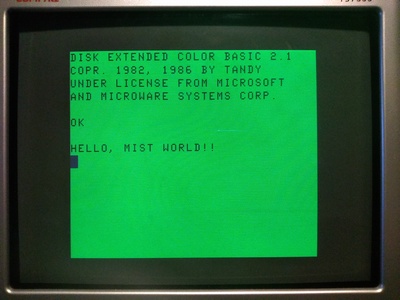

It was intended more as competition for Atari's ST series and the original Commodore Amiga.

CoCo 3: The last Color Computer has quite a collection of improvements as compared to the previous machines: true 80-column, higher resolution graphics, and more memory-the bare-bones configuration comes with 128 Kb of RAM that can be expanded up to 512k through Tandy, and up to 2Mb from third-party vendors.This CoCo was in the same price range of machines such as the Atari 8-bit series and the Commodore 64. Besides that, it has the same 64Kb/32-column limitation of its ancestor. Also, the later CoCo 2s were able to generate true lowercase letters (NOTE: later model CoCo 2s that said "Tandy" instead of TRS-80 had the lowercase) instead of "reverse video". The refinements consist mostly of a new, smaller case with a typewriter-looking keyboard and redesigned motherboard. CoCo 2: The Color Computer 2 is a refined-but fully compatible-version of the original Color Computer.By changing memory chips, setting jumpers, and removing some capacitors, the CoCo 1 memory could be expanded up to 64Kb, minimum to run OS-9 Level 1. Disk BASIC was the required environment to handle disk drives, and some third-parties created their own improved but compatible Disk Operating Systems (DOS). Later versions came with 16Kb/32Kb/64Kb and Extended Color BASIC. A compact cassette recorder or Program Paks were used. It was based on a design originally from Motorola. CoCo 1: The first Color Computer, it was first sold in 1980 and originally had only Color BASIC, 4Kb of memory, 32-column screen, and a chicklet keyboard.The different CoCo models are as follows: Use of a multipak (or MPI) allowed multiple cartridges to be inserted. Cartridges that support various functions, contain games, or drive peripherals can be inserted. On the right side, there is a cartridge slot.
COCO 3 EMULATOR AMIGA SERIAL
On the rear panel of the unit are connections for two analog joysticks, serial I/O (which can handle data transfer up to 9600 baud), cassette I/O, and TV/monitor output. Differing from an Apple ][+ or //e or an IBM, the CoCo comes with a variety of I/O ports built-in. Each CoCo comes with a variation of Microsoft BASIC built into its ROM. The name TRS-80 Color Computer, known as CoCo by its owners, refers to a family of Motorola 6809-based personal computers made by Radio Shack and produced from 1981 (CoCo 1) until 1990 (CoCo 3).
COCO 3 EMULATOR AMIGA PC
1.12 Tell me about CoCo Emulators for the PC (DOS/Windows/Mac/etc.).1.11 What is the pin-out of the RGB connector on the bottom of the CoCo 3?.1.10 What is the pin-out for the cassette and joystick ports?.1.9 What is the pin-out for the cartridge slot?.1.8.1 What are the POKEs for the baud rate?.1.8 How do I use the RS-232C I/O port (a.k.a.1.7 What is the wiring matrix for the keyboard?.


 0 kommentar(er)
0 kommentar(er)
